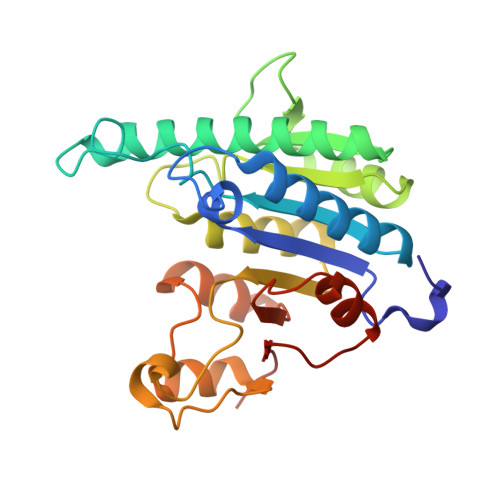Unique GTP-Binding Pocket and Allostery of Uridylate Kinase from a Gram-Negative Phytopathogenic Bacterium
Tu, J.-L., Chin, K.-H., Wang, A.H.-J., Chou, S.-H.(2009) J Mol Biol 385: 1113-1126
- PubMed: 19059268
- DOI: https://doi.org/10.1016/j.jmb.2008.11.030
- Primary Citation of Related Structures:
3EK5, 3EK6 - PubMed Abstract:
Using X-ray diffraction methodology, we have successfully determined the tertiary structures of the apo- and GTP-bound forms of uridylate kinase (UMPK) from the gram-negative plant pathogen Xanthomonas campestris with crystals grown under a strong magnetic field. The flexible ATP- and UMP-binding loops are clearly shown under this situation. X. campestris UMPK contains a unique patch of noticeably positive nature from residue R100 to residue R127, allowing it to form a special GTP-binding pocket in the central hole of the structure. Although GTP is found to be situated in a pocket similar to that of the ATP-binding pocket in Bacillus anthracis UMPK, superimposition between the two pockets indicates that they adopt very distinct conformations. Detailed structural analyses of X. campestris UMPK between its apo- and GTP-bound forms reveal that binding of GTP does not induce global conformational change for X. campestris UMPK and only moderates movements for the ATP- and UMP-binding loops. Binding of GTP effector seems to "heat up" X. campestris UMPK, causing overall increases of B-factors for the protein, except for residues interacting with the guanine base. Moderate increase of enzyme activity, as is the case detected in other gram-negative bacteria, is observed for X. campestris UMPK in the presence of an allosteric GTP effector. Given that the GTP molecules bind in the central cavity of the hexamer and that each GTP molecule interacts with more than one monomer, it is likely that binding of GTP modifies the hexameric assembly to exert long-range allosteric control on X. campestris UMPK, similar to that suggested for the effect of ATP effector on B. anthracis UMPK.
Organizational Affiliation:
Institute of Biochemistry, National Chung Hsing University, Taichung 40227, Taiwan, ROC.














